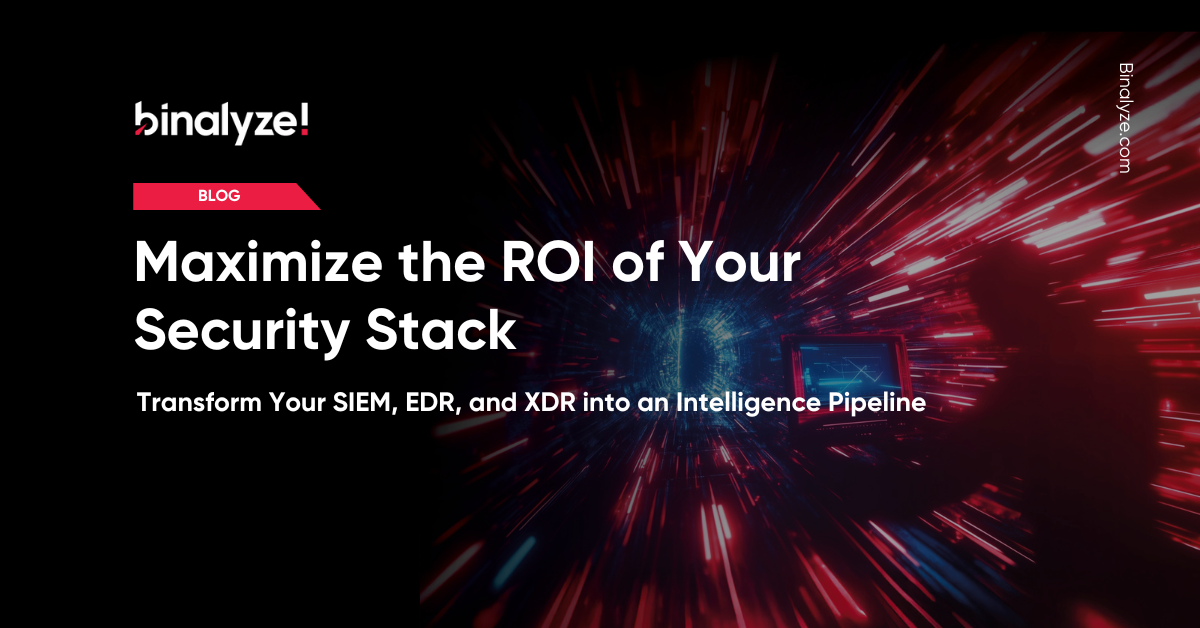
Transform Your SIEM, EDR, and XDR into an Intelligence Pipeline
Chief Information Officers (CIO) & Chief Information Security Officers (CISOs) are facing a shift in organizational priorities. While reducing cyber risk remains foundational, increasing operational efficiency and productivity has now emerged as the top enterprise priority. Close behind are the mandates to optimize or reduce costs and, for the first time, drive revenue growth through cybersecurity investments.
These evolving expectations create a pressing challenge: how can CISOs demonstrate tangible value from their existing security infrastructure, particularly in an era of budget constraints and rising demands for AI-driven efficiency?
The answer is not a costly rip-and-replace initiative. Instead, it lies in intelligently optimizing and integrating your current security stack. Your SIEM, EDR, and XDR platforms must evolve beyond functioning as high-volume alert generators. They must become a unified intelligence pipeline—central to decision-making, proactive threat hunting, and operational clarity.
The Challenge: Alert Overload, Disconnected Tools, and Underwhelming ROI
Security teams today are inundated with alerts from a sprawling mix of tools. This reactive “alert factory” approach drives inefficiencies and erodes ROI.
Common Pain Points:
-
Alert Fatigue: Analysts overwhelmed by alert volume, leading to burnout and decision fatigue, but also often in missed critical threats.
-
Siloed Telemetry: Data remains fragmented across on-prem, cloud, and endpoint tools, limiting visibility and investigative depth.
-
Underutilized Tools: Despite significant investment in SIEM, EDR, and XDR platforms, many organizations fail to unlock their full potential.
-
SOC Attrition: Analysts frustrated by fragmented systems and ineffective triage workflows often seek opportunities elsewhere.
The cumulative effect: organizations spend heavily on tools that don’t deliver expected returns—financially or operationally.
The Solution: Build an Intelligence Pipeline
To maximize value, your tools must function not in isolation but as a cohesive, data-driven ecosystem. When properly aligned, your SIEM, EDR, and XDR systems become a foundational intelligence pipeline—driving proactive detection, contextual triage, and operational excellence.
-
Consolidate and Rationalize Your Security Stack
Before adding new capabilities, assess and streamline what you already have.
-
Conduct a Tool Audit: Identify overlapping features, unused licenses, and redundant controls across your environment.
-
Reduce Vendor Sprawl: Where possible, consolidate functionality—e.g., can your XDR absorb functions from a standalone EDR?
-
Test & Evaluate with Tabletop Exercises, Drills and Red or Purple Teaming: Simulated breach scenarios can expose inefficiencies and pinpoint gaps for improvement to existing investments to improve efficacy.
Result: Streamlining tools and vendors can reduce cybersecurity expenditures, with EY highlighting savings of up to 35% annually, while enabling smoother integration and management.
-
Centralize Telemetry for Context-Rich Investigations
The core of an intelligence pipeline is centralized, enriched data that drives faster, more accurate decisions.
-
Universal Ingestion & Normalization: Your SIEM (or centralized data lake) should ingest logs, flows, alerts, and behavioral data from all sources—cloud, endpoint, and on-prem.
-
Enrich with Context: Layer threat intel, asset metadata, and business context into your dataset. This transforms noisy alerts into high-value insights. Consider the value of forensic data.
-
Enable Cross-Tool Correlation: Use correlation rules, machine learning, and advanced analytics to detect patterns no single tool would reveal.
Result: Unified visibility and smarter detection, especially for complex, multi-stage attacks.
-
Adopt a Risk-Based Approach to Security Operations
Maximizing ROI isn’t just about cost savings—it’s about aligning security efforts to what matters most.
-
Identify Critical Assets: Use frameworks like NIST, FAIR, or COBIT to define and prioritize your most valuable assets and risk areas.
-
Align Monitoring to Risk: Ensure that telemetry, alerting, and threat detection are focused on these crown jewels—not just log volume.
-
Let Data Guide Decisions: Use pipeline insights to inform staffing, tool configuration, and future investments.
Result: Security that is not only efficient, but also strategically aligned to business risk and resilience.
-
Empower Your SOC with Clarity and Confidence
A mature intelligence pipeline transforms SOC operations from reactive to proactive.
-
Reduce Alert Noise: Correlation and enrichment reduce false positives and allow analysts to focus on meaningful incidents.
-
Accelerate Triage: With contextual insights and full incident timelines, analysts can make faster, more confident decisions.
-
Enable Proactive Hunting: A centralized data lake and access to the right data allows threat hunters to search for hidden IOCs and advanced TTPs.
-
Automate Where Possible: Integrate SOAR capabilities to reduce repetitive tasks and accelerate response workflows.
Result: A more efficient, effective and engaged SOC team, better equipped to handle modern threats without burning out.
From Cost Center to Value Driver
The path forward is about smarter use of what you already have, then identifying gaps. By transforming your SIEM, EDR, and XDR platforms into a centralized, risk-aligned intelligence pipeline, you can:
-
Reduce operational costs by eliminating inefficiencies and redundant spend
-
Enhance your security posture with broader visibility and faster response
-
Boost SOC morale and performance with actionable insights and automation
-
Demonstrate business value by aligning security investments with productivity, cost optimization, and even revenue enablement
This shift doesn't require ripping out existing infrastructure—it requires smart integration and strategy, as well as a willingness to explore a mindset shift. Automated Investigation and Response solutions like Binalyze AIR can amplify your existing ecosystem by rapidly extracting forensic-level data across your environment, elevating your team's investigative capabilities and integrating seamlessly into your pipeline for deeper, faster investigations.
We recommend beginning with a third-party maturity assessment to identify quick wins and strategic gaps. From there, your organization can evolve its security stack into a force multiplier—not a cost center—delivering measurable value in 2025 and beyond.









